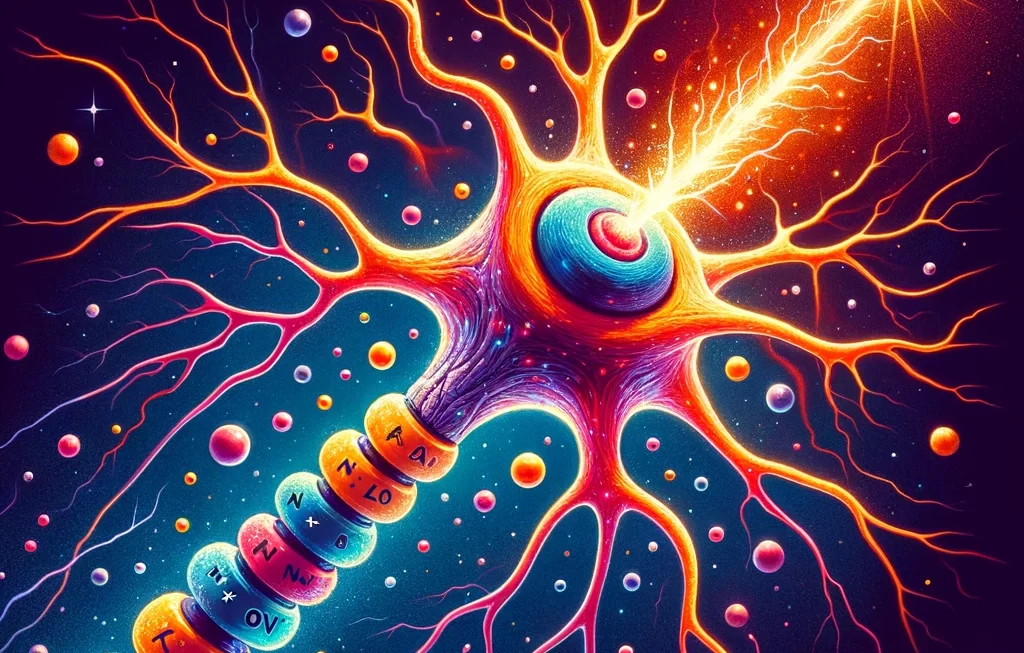Welcome to the fascinating world of biopsychology, where the mysteries of the mind and behavior meet the intricate mechanics of the body. Whether you’re a curious newbie or someone with a budding interest in how our brain cells communicate, you’re in the right place. This article will take you on a journey through the microscopic world of neurons and nerve impulses, breaking down complex concepts into easy-to-understand explanations. Get ready to unlock the secrets of your own nervous system!
Action Potentials: The Spark of Life
At the heart of neural communication lies the action potential, a tiny but mighty electrical impulse that travels along neurons. Imagine the action potential as a spark that ignites the engine of our thoughts, movements, and sensations. It’s the fundamental signal that neurons use to communicate, allowing us to think, feel, and interact with the world around us.
Example: Consider how a light switch works. You flip the switch, and suddenly, the room is illuminated. An action potential works similarly in neurons. When a neuron “decides” to send a message, it creates an electrical pulse. This is like flipping a switch, causing a wave of electricity to travel down the neuron. It’s the start of how you might pull your hand back from a hot stove or remember the lyrics to your favorite song.
Ionic Basis of Action Potentials: A Delicate Dance of Ions
The creation of an action potential is a masterpiece of nature, involving a delicate balance of ions (charged particles) moving in and out of neurons. Sodium (Na+) and potassium (K+) ions play the starring roles in this process. When a neuron is stimulated, sodium ions rush into the cell, followed by potassium ions flowing out. This dance of ions changes the electrical charge inside the neuron, creating the action potential.
Example: Imagine a crowded dance floor, where dancers (ions) move in and out in a choreographed manner. Initially, the dance floor (inside of the neuron) has more negative charges, while the party outside has more positive ones. When the music (stimulus) hits just right, the doors (ion channels) open, and dancers (sodium ions) rush in, changing the vibe inside. Shortly after, another group (potassium ions) decides to leave, restoring balance. This in-and-out movement creates the action potential, the neuron’s way of dancing to the beat of the brain’s commands.
All-or-None Principle: It’s All or Nothing
A fascinating aspect of action potentials is the all-or-none principle. This means that once the neuron’s threshold is reached, an action potential will fire at full strength or not at all. There’s no halfway—similar to flipping a light switch on or off. This ensures clear, decisive messages are sent across neurons, leaving no room for confusion.
Example: Think of launching a rocket. If the conditions aren’t perfect, the launch doesn’t happen. But once everything is set—fuel, weather, systems check—the rocket launches at full force. Neurons operate on a similar principle. They either fire an action potential with all they’ve got or don’t fire at all, ensuring messages are sent clearly and decisively, like a rocket soaring into space or a decision made without hesitation.
Propagation of Action Potentials: The Relay Race
After an action potential is generated, it doesn’t just stay put—it races along the neuron’s axon to its destination. This is akin to a relay race where the baton (the action potential) is passed swiftly from one section of the axon to the next. Myelin sheaths, insulating layers around the axon, speed up this process, ensuring that the message reaches its target quickly and efficiently.
Example: Visualize a relay race where runners pass a baton along a track. Each runner represents a segment of the neuron’s axon, and the baton is the action potential. Once the race starts (the neuron fires), the baton is passed swiftly from one runner to the next (the electrical impulse travels down the axon). If the track is coated with a special material (myelin sheath), the runners (impulses) move faster, ensuring the message reaches its destination quickly. This is how you can instantly feel the texture of an object or react to a sudden sound.
Conclusion
From the spark of the action potential to the intricate ionic dance that powers it, the journey of nerve impulses across neurons is truly a marvel of biology. It underpins every thought, movement, and sensation, highlighting the incredible complexity and efficiency of our nervous system. By understanding these fundamental processes, we gain deeper insights into how our brains work, opening doors to new discoveries in neuroscience and psychology.
Q: What is a neuron? A: A neuron is a nerve cell that is the basic building block of the nervous system, responsible for transmitting information throughout the body.
Q: How fast do action potentials travel? A: The speed can vary from 1 meter per second to over 100 meters per second, depending on the neuron’s diameter and whether it’s myelinated.
Q: Can neurons regenerate after injury? A: Neurons have limited ability to regenerate. While peripheral neurons can regrow under certain conditions, central nervous system neurons face more challenges in regeneration.
Q: Can action potentials vary in strength? A: No, action potentials follow the all-or-none principle, meaning they always fire at the same intensity, much like a rocket launch—it either happens fully or not at all.
Q: Do all neurons transmit signals at the same speed? A: Speed can vary based on the presence of myelin sheath and the diameter of the neuron, similar to how different surfaces can affect the speed of runners in a relay race.
Further References and Additional Reading
- “Biopsychology” by John P.J. Pinel – A comprehensive guide to understanding the biological bases of behavior.
- “The Brain from Top to Bottom” – An online resource offering various levels of explanation for neuroscience topics.
- Khan Academy’s Neuroscience section – Provides easy-to-understand videos on neural communication and other related topics.




